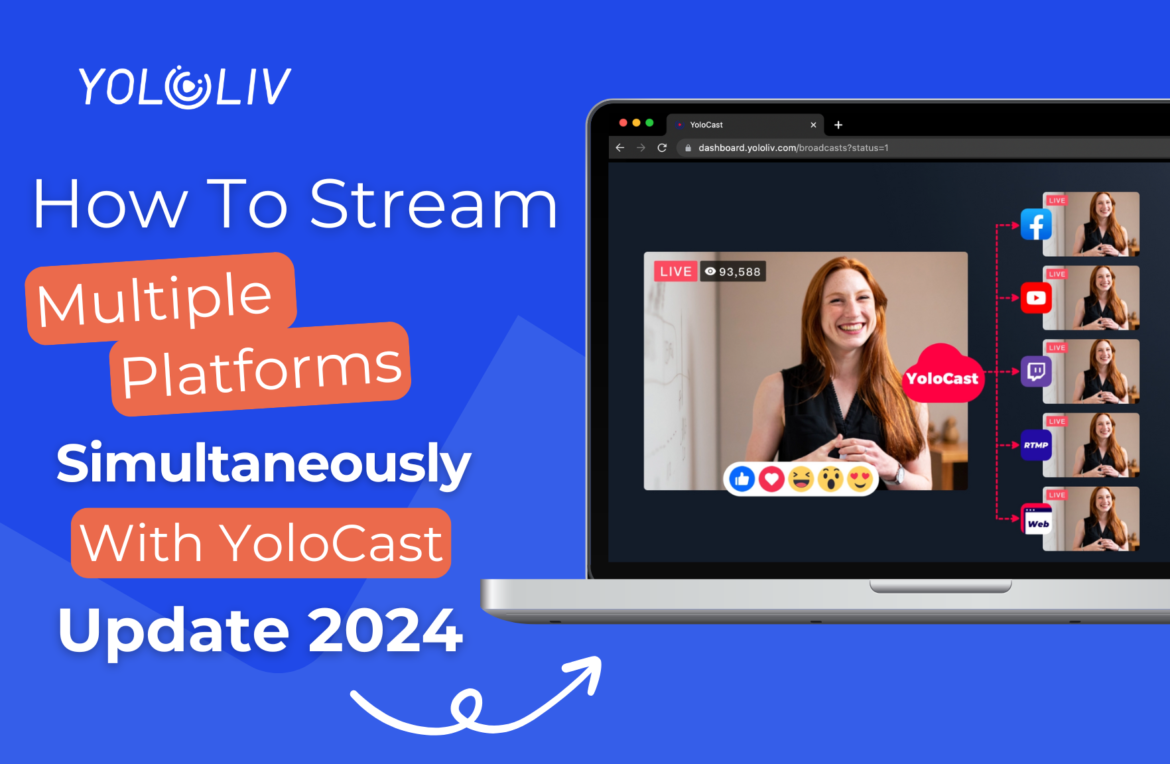In today’s world, nearly every major social media platform offers live streaming options, whether it’s YouTube, Facebook, Twitch, or even LinkedIn. The live-streaming industry is set to hit $416.84 billion by 2030, which means the trend of live video content is here to stay. But relying on just one platform isn’t enough anymore. Broadcasting only on YouTube or Facebook means you’re missing out on a huge potential audience on other platforms.This is where multi-streaming comes in. By broadcasting your content to multiple platforms simultaneously, you ensure that your live stream reaches a broader audience, no matter which platform they prefer. Multi-streaming lets you expand your reach without adding extra work, helping you stand out in the competitive world of live streaming.
What is Multi-Streaming?
Multi-streaming, or simulcasting, involves broadcasting live video content across more than one platform at the same time. Imagine you’re live streaming on YouTube, but your content is also going live on Facebook and Twitch. This allows you to tap into multiple audience segments simultaneously.
Without multi-streaming, you’d have to choose one platform, which could limit your reach. Alternatively, you could stream separately on each platform, but this would be time-consuming and inefficient. Multi-streaming solves this by allowing you to stream across different platforms in a single session, making your content accessible to a much wider audience.
Why Should You Multistream?
Before creators had the option to multistream, managing live broadcasts across various platforms was a complex and time-consuming task. Each platform required its own individual stream setup, often leading to missed opportunities and fragmented audience engagement. Today, multi-streaming has transformed this landscape, offering several compelling reasons why you should integrate this strategy into your content creation approach.
1. Multiply Your Audience
The most obvious benefit of multistreaming is expanding your audience. Broadcasting to just one platform—whether it’s YouTube, Facebook, or Twitch—means you’re only reaching users on that platform. But when you multistream, you’re able to broadcast to all your channels simultaneously, reaching audiences where they prefer to watch. This gives you a massive potential to grow your audience by tapping into multiple communities at once.
2. Save Time and Effort
Managing separate live streams for each platform would be incredibly time-consuming and impractical. With multistreaming, you only need to create one broadcast that’s sent to multiple destinations. This reduces the time and effort needed to set up and manage separate streams. YoloCast makes this process seamless by allowing you to manage your multi-stream setup from a single dashboard, saving you from the hassle of jumping between platforms.
3. Attract New Viewers
By appearing on more platforms, you increase your chances of attracting new viewers. Different audiences prefer different platforms—some might be loyal to YouTube, while others are more active on Facebook or Twitch. By multistreaming, you meet viewers where they are, giving them the chance to discover your content. This can also help you grow a more diverse and engaged following, as new viewers find and stick with your content.
4. Diversify Your Income Streams
More platforms mean more opportunities to monetize your streams. Each platform has its own ways for creators to earn income, whether through ads, donations, subscriptions, or sponsored content. By multistreaming, you can take advantage of these different revenue streams simultaneously, creating a more diversified income strategy. This is especially important if you want to reduce reliance on one platform and build a more resilient income model.
5. Protect Your Stream from Technical Issues
Another key benefit of multistreaming is that it helps avoid the headaches caused by technical problems on any single platform. Streaming to just one destination means that if there’s a server issue or outage, your entire live broadcast could be disrupted. However, with multistreaming, if one platform experiences an issue, your stream will continue smoothly on other platforms, minimizing downtime and ensuring your audience stays connected.
How to Stream to Multiple Platforms Simultaneously?
If you’re ready to start multistreaming and reach a wider audience, it’s essential to know how to get everything set up. Streaming to multiple platforms may seem complex, but with the right tools, it’s easier than ever.
1. Choose the Platforms You Want to Stream To
The first step in multistreaming is deciding where you want to broadcast your content. Popular platforms include YouTube, Facebook, Twitch, but you’re not limited to just these. Consider where your audience is most active and what platforms align best with your content. For example, gaming content may perform better on Twitch, while business-focused live streams might thrive on LinkedIn.
While making your selection, be sure to check whether the platforms support RTMP or SRT stream keys, as these are essential for most live streaming setups. Additionally, each platform may have specific rules or limitations that could affect your stream. For example, as of 2024, X (formerly Twitter) has updated its live streaming policy, restricting live streaming to paid members only. Similarly, newer platforms like Kick.com have risen in popularity, but their API limitations prevent some live streaming solutions from directly supporting them. It’s essential to stay updated on these policies to ensure smooth streaming.
2. Choose the Right Multistreaming Solution
After identifying your platforms, the next step is to find a multistreaming solution that fits your needs. YoloCast is an ideal option for content creators and businesses looking for a seamless way to multistream. As a cloud-based multistreaming platform, YoloCast allows you to broadcast to up to 30 destinations at once with it’s exclusive or business plan, giving you the flexibility to reach all your chosen platforms.
YoloCast offers advanced features like cloud-based streaming, custom RTMP destinations, and real-time analytics, making it simple for you to manage everything from one place. The platform is designed to make multistreaming accessible, whether you’re a small business or an experienced content creator. There’s no need for expensive hardware setups or complicated technical processes—YoloCast does the heavy lifting for you.
3. Start Multistreaming on YoloCast
Now that you have your platforms and multistreaming tool, it’s time to start streaming. Here’s how to set up multistreaming on YoloCast:
1. Login and Navigate
Access your YoloCast account, and head to the Destinations page.
2. Platform Integration
Facebook, YouTube, and Twitch can be added directly. For other platforms, you’ll need to use an RTMP address.
RTMP Address Integration
1. Click on RTMP(s), triggering a box to appear for entering the RTMP destination address.
2. Copy the right RTMP address from where you’re streaming. Here we take YouTube Live as an example.
3. Hit the “Add Platform” button, and just like that, it’s seamlessly integrated!
3.Set up your live stream event and hit “Go Live.”
By following these steps, you can easily multistream with YoloCast, expanding your reach and engaging with audiences across multiple platforms without the hassle of managing separate streams.
For more information, you can also check the blog: How to Multistream to 30 Destinations Using YoloCast & YoloBox Pro
Conclusion
In conclusion, multistreaming has become an essential tool for content creators, businesses, and live event broadcasters looking to expand their reach and engage a larger audience. With YoloCast, multistreaming to up to 30 destinations is not only easy but also highly effective. YoloCast’s advanced features, such as 24/7 live streaming with pre-recorded videos, scheduling and auto-start, and website embedding, give you full control of your live broadcasts, making it a versatile and powerful platform. Whether you’re a beginner or a seasoned professional, YoloCast simplifies the process, allowing you to focus on creating high-quality content while the platform handles the rest. Click the link to start a free trial: https://www.yololiv.com/yolocast-overview
5,256 total views, 11 views today

Hailey, a Customer Success Specialist at Yololiv, she brings immense enthusiasm to assisting users in understanding the various features of YoloCast and resolving any usage-related issues they may encounter. Alongside her support efforts, she also curates articles sharing tips, troubleshooting advice, and other helpful insights to enhance users’ experience with YoloCast.


